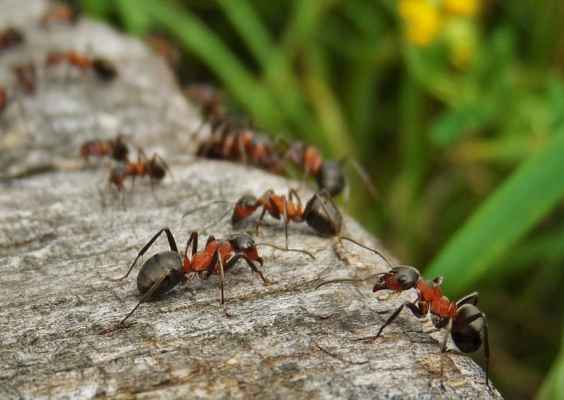Pest Control for Carpenter ants differs from termite control, which uses wood as a food source and will eat sound wood. Carpenter ant do not eat wood; they nest in wet or water-damaged wood. Sometimes they find a void to serve as a nesting area.

Most carpenter ant damage occurs during the summer months. Large numbers of ants can be destructive, yet sometimes they are more of a nuisance than a serious threat to the structure as they eat wood to make a nest there and they don’t eat wood as food. If you see ants in number should consult and seek help for carpenter ant control.
Remember that a few ants do not always mean that an infestation is present. Early in the spring, before their regular food is present, workers often wander inside homes looking for sweets. They will scavenge for fats and other foods.
Here you can get carpenter ants to control services in different locations, carpenter ant control surrey, carpenter ants control Delta, carpenter ants control Langley, carpenter ants control Abbotsford, carpenter ants control Burnaby, and carpenter ant control British Columbia
How to Inspect for Carpenter Ants Control
Live Ants
Outside the house at night, use a flashlight (preferably with a red cellophane filter) to find live ants. Examine the foundation, stairs, deck, porch, landscaping timbers, utility wires, and branches of trees and shrubs touching the house. Carpenter ant are nocturnal and will move in and out of your house at night to feed.

- Sawdust
Sawdust is a hint for carpenter ant control. Inside the house, look for small piles of sawdust and moisture-damaged wood. Check corners near walls, inside walls from attic to basement, windows, and skylights. Piles of sawdust are from excavations.
- Nests
Search for nests in wall voids beneath window sills, inside doors, under fiberglass insulations. Void areas are good nesting sites (because carpenter ants are considered too “lazy” to excavate sound wood). Check hollow staircase railings, even inside wooden curtain rods. Searching and destroying the nests is good for carpenter ant control.
Carpenter ants first create the main colony (nest). As the colony grows, the ants form satellite nests. In managing carpenter ants, it is important to locate all the nests. The main colony and satellite nest, if present, can exist inside the house or outside, near the house. Look along with the chimney, where it joins the house, especially if covered with ivy. Extermination of the colony is a major help in carpenter ant control.
- Debris
Try to find distinct piles of debris that contain insect parts, and pieces of pupal cases discarded by worker ants. Look under sills, insulation; near openings in secluded walls (cupboards, closets).
- Winged Adults
During the winter, locate winged adults inside, near windows. Ants will be no more than 30 feet from the nest. Their presence indicates an indoor nest because normal outdoor emergence time would NOT be winter!
- Trails
Look for live ants outside during the day. Remember that ants avoid sunlight. Search the shady sides of linear objects (garden hoses, picket fences, under logs). Also, check branches touching the ground and look for shallow ant tunnels in the ground. Inspect for ants following trails inside, along pipes and electrical wires. Carpenter ant sometimes follow straight routes and leave scent trails.

Find out here carpenter ants control services with these locations carpenter ant control surrey, carpenter ants control Vancouver, carpenter ants control Delta, carpenter ants control Langley, carpenter ants control Burnaby, and carpenter ant control Abbotsford
Exopest Pest Control can give you relief for your carpenter ant problems.
How to treat carpenter ants:
One way that has been proven to be effective in treating carpenter ant is baiting them during the summer when they actively search for food, and when we see their trails we can use baits (which can only be purchased by a professional and licensed pest control company). These baits are safe for kids and pets to use.
In chemical treatment, we can inject chemicals into the walls to kill the nest, but in this method, we sometimes need to make holes in the walls where the chemicals can be injected. Call Us 6047601542

